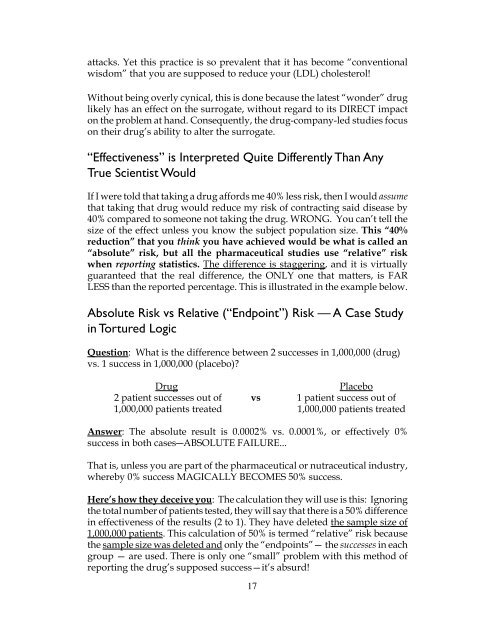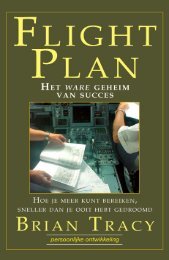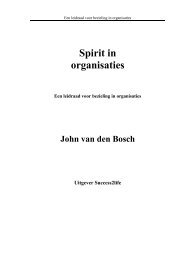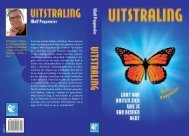The Peskin Primer - Succesboeken
The Peskin Primer - Succesboeken
The Peskin Primer - Succesboeken
Create successful ePaper yourself
Turn your PDF publications into a flip-book with our unique Google optimized e-Paper software.
attacks. Yet this practice is so prevalent that it has become “conventional<br />
wisdom” that you are supposed to reduce your (LDL) cholesterol!<br />
Without being overly cynical, this is done because the latest “wonder” drug<br />
likely has an effect on the surrogate, without regard to its DIRECT impact<br />
on the problem at hand. Consequently, the drug-company-led studies focus<br />
on their drug’s ability to alter the surrogate.<br />
“Effectiveness” is Interpreted Quite Differently Than Any<br />
True Scientist Would<br />
If I were told that taking a drug affords me 40% less risk, then I would assume<br />
that taking that drug would reduce my risk of contracting said disease by<br />
40% compared to someone not taking the drug. WRONG. You can’t tell the<br />
size of the effect unless you know the subject population size. This “40%<br />
reduction” that you think you have achieved would be what is called an<br />
“absolute” risk, but all the pharmaceutical studies use “relative” risk<br />
when reporting statistics. <strong>The</strong> difference is staggering, and it is virtually<br />
guaranteed that the real difference, the ONLY one that matters, is FAR<br />
LESS than the reported percentage. This is illustrated in the example below.<br />
Absolute Risk vs Relative (“Endpoint”) Risk — A Case Study<br />
in Tortured Logic<br />
Question: What is the difference between 2 successes in 1,000,000 (drug)<br />
vs. 1 success in 1,000,000 (placebo)?<br />
Drug<br />
Placebo<br />
2 patient successes out of vs 1 patient success out of<br />
1,000,000 patients treated 1,000,000 patients treated<br />
Answer: <strong>The</strong> absolute result is 0.0002% vs. 0.0001%, or effectively 0%<br />
success in both cases―ABSOLUTE FAILURE...<br />
That is, unless you are part of the pharmaceutical or nutraceutical industry,<br />
whereby 0% success MAGICALLY BECOMES 50% success.<br />
Here’s how they deceive you: <strong>The</strong> calculation they will use is this: Ignoring<br />
the total number of patients tested, they will say that there is a 50% difference<br />
in effectiveness of the results (2 to 1). <strong>The</strong>y have deleted the sample size of<br />
1,000,000 patients. This calculation of 50% is termed “relative” risk because<br />
the sample size was deleted and only the “endpoints”— the successes in each<br />
group — are used. <strong>The</strong>re is only one “small” problem with this method of<br />
reporting the drug’s supposed success—it’s absurd!<br />
17













